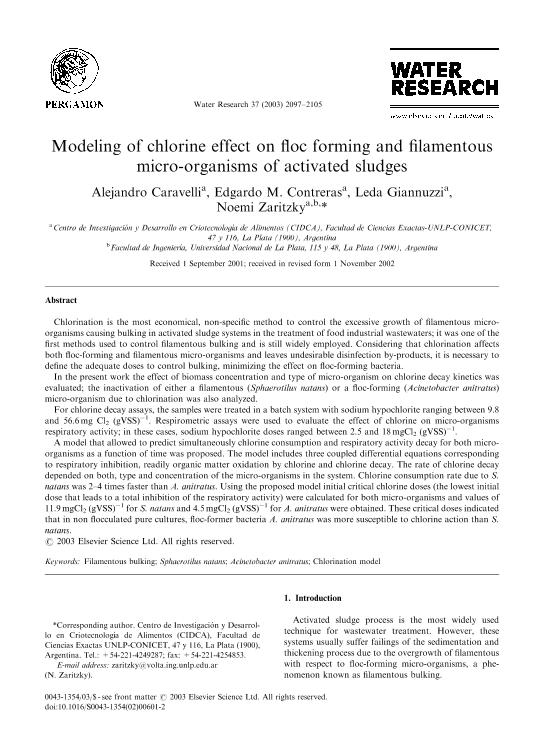Artículo
Modelling of chlorine effect on floc forming and filamentous micro-organisms of activated sludges
Caravelli, Alejandro Horacio ; Contreras, Edgardo Martin
; Contreras, Edgardo Martin ; Giannuzzi, Leda
; Giannuzzi, Leda ; Zaritzky, Noemi Elisabet
; Zaritzky, Noemi Elisabet
 ; Contreras, Edgardo Martin
; Contreras, Edgardo Martin ; Giannuzzi, Leda
; Giannuzzi, Leda ; Zaritzky, Noemi Elisabet
; Zaritzky, Noemi Elisabet
Fecha de publicación:
03/2003
Editorial:
Pergamon-Elsevier Science Ltd
Revista:
Water Research
ISSN:
0043-1354
Idioma:
Inglés
Tipo de recurso:
Artículo publicado
Clasificación temática:
Resumen
Activated sludge technology is more used than any other for biological treatment of wastewater. However, filamentous bulking is a very common problem in activatedslud ge plants, chlorine being the chemical agent normally used to control it. In this work the effect of chlorine on microorganisms present in activatedslud ge flocs was assessed by a respirometric technique (oxygen uptake rate, OUR) and by the INT-dehydrogenase activity test (DHA) measured by two techniques: spectrophotometry (DHAa) andimage analysis (DHAi). Both DHA tests were optimized and correlated with the respirometric technique (OUR) using pure cultures of a filamentous microorganism (Sphaerotilus natans) under chlorine inhibition. Using these correlations the tested methods were applied to determine the action of chlorine on respiratory activity in activatedslud ge. The OUR andthe DHAa quantifies the action of chlorine on the total respiratory activity (RA) of flocs (filamentous andfloc-forming bacteria); in contrast, the DHAi test evaluatesspecific action of chlorine on the RA of filamentous microorganisms.In activated sludge flocs containing filamentous microorganisms, a chlorine dose of 4.75mg Cl2 (gVSS)1 with a contact time of 20 min reduced about 80% of the RA of filamentous bacteria while affecting only 50-60% of the total RA of flocs. Besides, a chlorine dose of 7.9 mgCl2 (gVSS)1 produced the total respiratory inactivation of filamentous microorganisms after 10 min contact, however, with this dose the total RA of activated sludge flocs was reduced only about 45–65%; controlling filamentous bulking without affecting too much floc-forming bacteria.At the testedchlorine concentrations the inhibition of filamentous microorganisms was higher than in the whole activated sludge. Although floc-forming microorganisms were demonstrated to be more susceptible to chlorine than filamentous in pure cultures, results obtainedin the present work confirmed that it is the location of the filamentous microorganisms in the flocs and the presence of extracellular polymer substances which largely determines their higher susceptibility to chlorine; consequently this feature plays a critical role in bulking control.
Palabras clave:
S.natans
,
filamentous microorganisms
Archivos asociados
Licencia
Identificadores
Colecciones
Articulos(CCT - LA PLATA)
Articulos de CTRO.CIENTIFICO TECNOL.CONICET - LA PLATA
Articulos de CTRO.CIENTIFICO TECNOL.CONICET - LA PLATA
Articulos(CIDCA)
Articulos de CENTRO DE INV EN CRIOTECNOLOGIA DE ALIMENTOS (I)
Articulos de CENTRO DE INV EN CRIOTECNOLOGIA DE ALIMENTOS (I)
Citación
Caravelli, Alejandro Horacio; Contreras, Edgardo Martin; Giannuzzi, Leda; Zaritzky, Noemi Elisabet; Modelling of chlorine effect on floc forming and filamentous micro-organisms of activated sludges; Pergamon-Elsevier Science Ltd; Water Research; 37; 3-2003; 2097-2105
Compartir
Altmétricas



